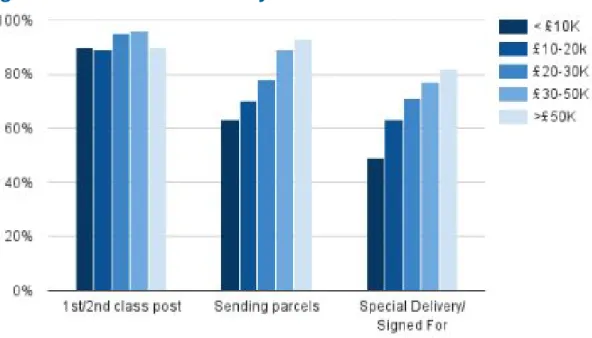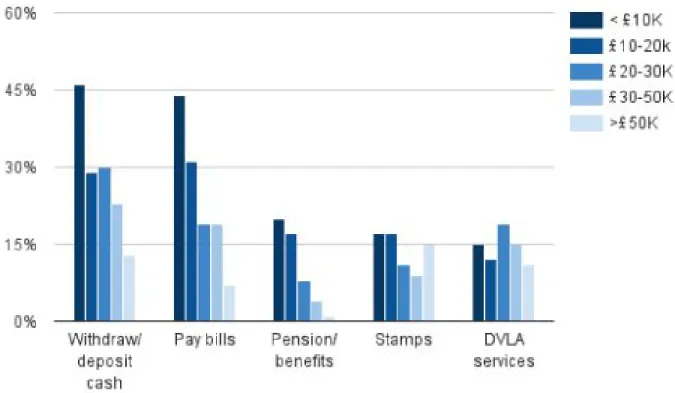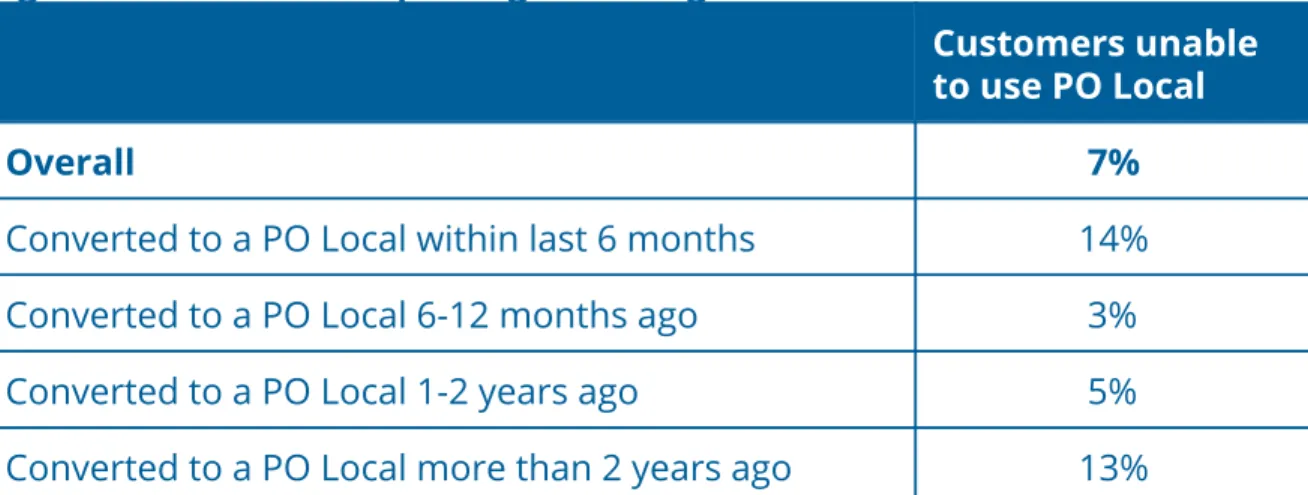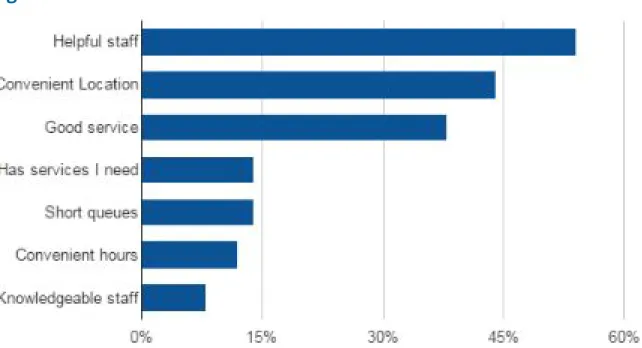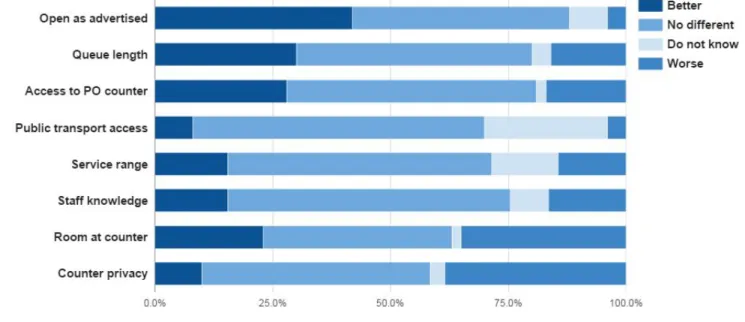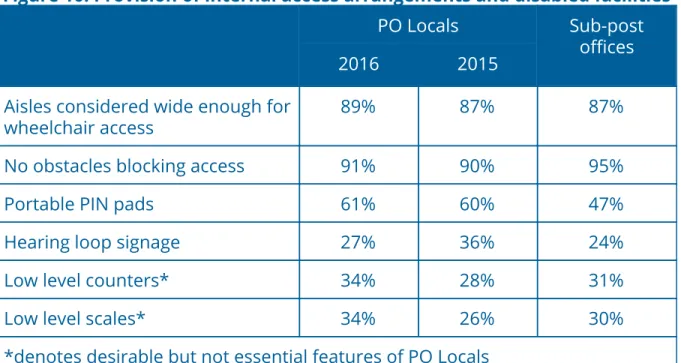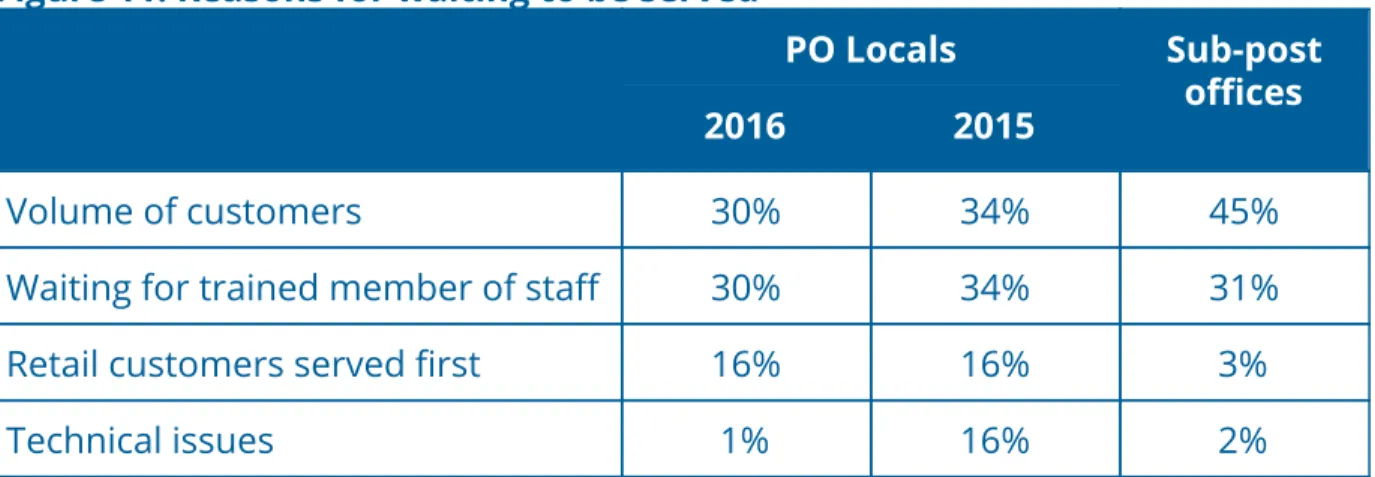It compares the performance of PO Locals against our previous survey waves. And for the first time, it compares the performance of PO Locals to traditional sub-post offices. PO locals seem to be most popular with younger and more affluent customers who are especially likely to use premium postal and parcel services.
Conversely, many of the Postal Service's core customers, such as the elderly, disabled and lower income consumers, are slightly less satisfied with PO Locals and are less likely to use extended hours. While our research shows that PO Locals generally perform in line with sub-post offices, the new model appears to have introduced some trade-offs. The type and number of scenarios performed and branch attributes assessed varied across PO Locals and sub-post offices.
2 out of 3 use PO Locals for premium postal services such as Special Delivery or Recorded Signed Delivery.
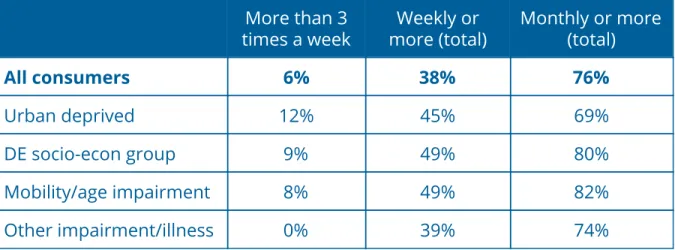
Availability of services
This is perhaps an encouraging sign 8 of the continued confidence placed in the postal network and may be linked to the ongoing bank closures. In some cases, reported customer concerns could be addressed with better signage: in 16% of mystery shopping visits, advertised branch opening hours did not match those on the website, up from 9% in the last wave. Our recent operator experience research suggested that due to staffing issues, some operators are finding it difficult to keep branches open to their contracted hours, particularly if they have had to extend their normal hours to host a post office.
In nearly 2 in 5 (38%) visits, mystery shoppers did not see a full menu of services on the outside of the PO Local branch. This will help to promote extended opening hours (where relevant) and ensure that customers have appropriate expectations of the service.
Trade-offs
Accessibility and branch environment
Our findings show that most consumers are satisfied with the PO Local, with the model offering improved access for disabled people compared to traditional sub-post offices. The main reasons for satisfaction are: 12 friendly, helpful and polite staff, the convenient location of the branch and the perceived good service. Satisfaction continued to be highest among consumers using branches that converted to the PO Local model in an existing premises (on-site conversions) and PO Locals operated by independent retailers.
Conversely, there was slightly more dissatisfaction with PO Locals among branches that moved and converted to the model in another premises (off-site conversions), PO Locals operated by multiple group retailers, older age groups and those with lower incomes. As shown in figure 7, the most prominent reasons for dissatisfaction with PO Locals were queuing problems or a lack of privacy. We asked consumers who have noticed changes to their branch since converting to a PO Local how they feel.
Overall, more consumers appear to be happy about improved counter access and queue times. On-premise conversions, customers are happier with both, while with off-premise transfers, they feel things have gotten worse. This leads to a broader overall pattern of higher satisfaction for on-site than off-site conversions.
Dissatisfaction is greater for off-site conversions across all measures except for branch open in line with hours. For example, consumers are twice as likely (21% compared to 10%) to think that staff knowledge has worsened when the conversion has moved off-site. Consumers who think the following changes are better or worse after converting the branch to a PO Local.
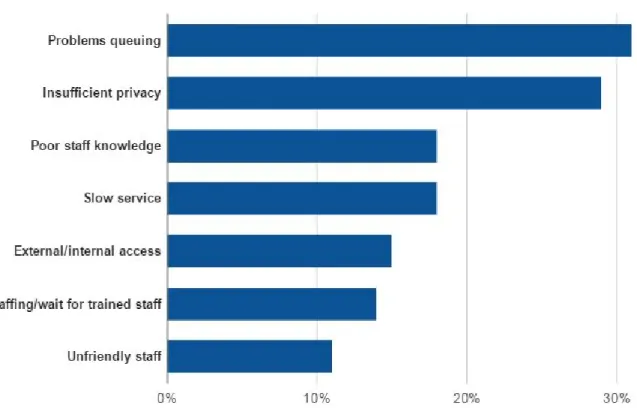
Accessibility
Of these customers, 1 in 5 (20%) thought that access arrangements were not sufficient and that the provision of a ramp or easier access door would help to improve access. Similar relationships felt that the branch layout needed to be improved or extra accessibility facilities provided. This includes providing seating or more space to make it easier to move around within the branch.
Our mystery shopping shows that the provision of level access (including 15 . permanent ramps) in PO Locals has improved. This is better than traditional sub-post offices (79%), suggesting that the model can offer better performance in this area. Only 4% of local POs offered no support or signs around support for access, compared to 7% of subposts.
We welcome the commitment in NTP not to reduce physical access beyond the threshold when a branch is converted to a Local PO. Our 15 mystery shoppers used for research were not disabled, however their knowledge is a useful indicator of how accessible branches are to customers with disabilities. As illustrated in Figure 10, although a slight improvement from the previous wave, corridors were still not considered wide enough for wheelchairs in 1 in 10 (11%) local PO visits.
Shoppers found that some of the disability facilities that were supposed to be included in the PO Local model were also lacking, although PO Locals outperformed both our last wave and traditional branches. As POL has committed to these forming part of the normal range of disability facilities in PO Locals, it is a concern that they were not provided in such a large number of visits. Although not part of the PO Local model, separate low-level counters or scales were provided in only 1 in 3 (34%) visits.
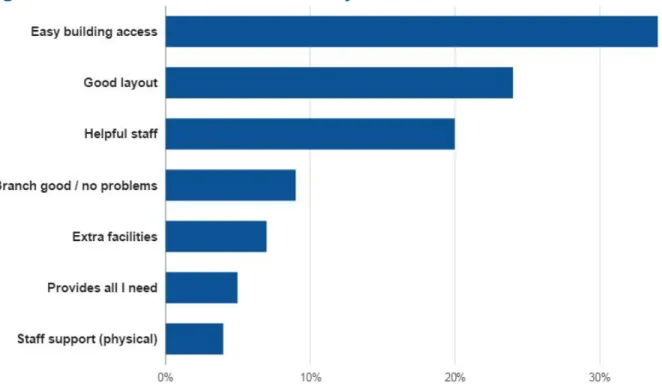
Queuing times and counter environment
Service standards: Mail
Buyers were asked about the letter's content (33%) or its value (20%) before being offered a recommendation in a minority of PO Locals visits. In the remaining visits to PO Locals (12%) and sub post office visits (9%) staff did not offer second class large letter mail at all. Overall, 85% of PO Locals and 91% of sub-post offices provided shoppers with the correct service either initially or after further requests.
Staff are most often offered Signed to Second Class along with other options in both PO Locals (52%) and Sub Post Offices (57%). On the remaining visits, staff did not offer Signed for Second Class postage at all. Overall, most PO Locals (84%) and traditional models (76%) offered the correct single recommendation to begin with or upon prompting.
As shown in Figure 15, staff asked questions at PO local units and sub-post offices with similar frequency. It is encouraging that during most of the visits to PO, local employees and employees of sub-post offices weighed packages, asked about Again, the most common outcome for domestic POs (60%) and sub-post offices (66%) was a correct recommendation in addition to at least one less suitable option.
Overall, after asking most PO Locals (88%) and Sub-Post Offices (93%), 24 gave customers a correct, simple recommendation either first or after reiterating their needs. It is encouraging that more employees at PO Locals ask appropriate questions to determine customer needs before properly offering special delivery. In the remaining 7% of PO Locals visits, customers were offered a range of first class postage options including normal first class postage, large letter postage or Signed For.
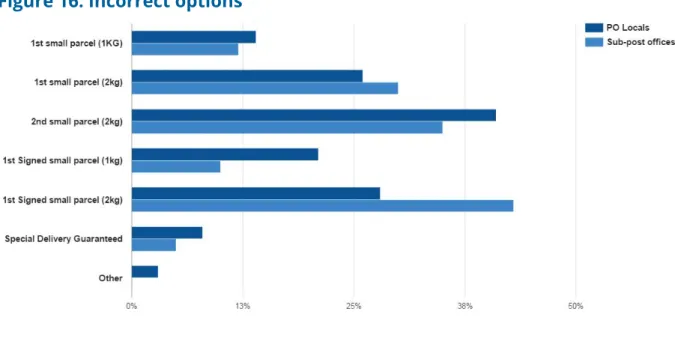
Service standards: cash and collection
In October 2016 POL increased the cash deposit limit on PO Locals to £2,000, which is a welcome development for small businesses. Although most provided an answer of between £1,000 and £3,000, miscommunication of key aspects of the business cash deposit service may result in small businesses not feeling able to fully trust PO Locals as a suitable banking alternative. Our mystery shoppers asked about Local Collect and Amazon Prime collection services from PO Locals.
Sub-postals (94%) were slightly more likely than PO Locals (87%) to tell shoppers they could use Local Collect in branch. However, in a significant minority of these unsuccessful visits, in all PO local residents (37%) and sub-post office (22%) staff stated that the branch did not have enough space to store the parcel or asked shoppers to use a larger branch. Shoppers conducting the Local Collect investigation also tested Amazon's collection service offering.
In the majority of both PO Local and subpost office visits, shoppers were able to use the Local Collect and Amazon shopping collection services, and improvements were made to the provision of Local Collect service at PO Locals. PO Locals should offer the full range of UK parcel services up to 20kg, if. It is worrying that in such a large number of visits to both PO Locals and sub-post offices, shoppers were provided with an incorrect weight limit for parcels.
This finding is consistent with previous findings from the Local Collect and Amazon collection survey and from our customer experience survey. 33 This scenario was carried out by all shoppers at both PO Locals and sub-post offices. This was done by shoppers who did not complete the Local Collect and Amazon collection survey.
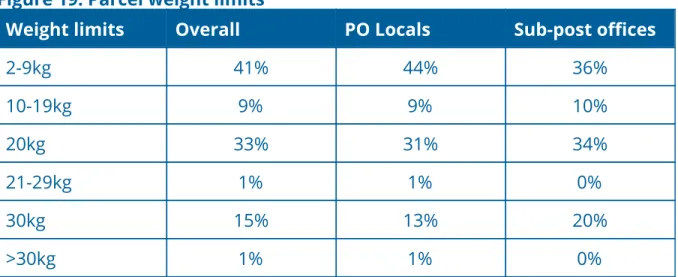
5 Use of extended opening hours
Awareness and use of extended opening hours
Frequency and use of services
Service standards in extended hours
Despite the seemingly lower use of PO Locals during extended hours among those on lower incomes, in lower socio-economic groups or with mobility or age-related disabilities, a large number still appear to use the model during these hours to send first or second class letters or withdraw or deposit cash. Customers are less likely to have to wait after hours, except on Saturday, when almost half (49%) were not served immediately. As the table below shows, staff were initially less likely to offer a single, correct recommendation in email scenarios during extended hours compared to regular hours.
As illustrated in the table below, extended hours staff were more reliant on customers reiterating their needs before recommending the service. Apart from the second class scenario in capital letters, despite customers repeating their needs, staff were also more likely to still recommend the wrong service. Despite the poorer service quality of PO Locals in the post scenarios during extended hours, 98% of merchants visiting both core and extended hours were able to withdraw cash.
When shoppers asked if they could use the branch to deposit money, staff on extended hours were more likely (78%) to confirm the availability of this service than staff on core hours (68%). Performance is the same during extended hours for Amazon shopping collection, but Local Collect services are almost twice as likely to be unavailable (19% compared to 11% during core hours). One possible reason is that native POs are more likely to have extended part-time hours and more transient workers than core hours.
Our recent research suggests that some PO Local operators have difficulty ensuring that the branch is adequately staffed during long hours. Our findings suggest that although customers may receive a faster service during extended opening hours, the quality of service is often poorer. In a greater proportion of visits during long hours, staff do not ask enough questions to determine buyers' needs and are more dependent on buyers repeating their needs to recommend the correct service.
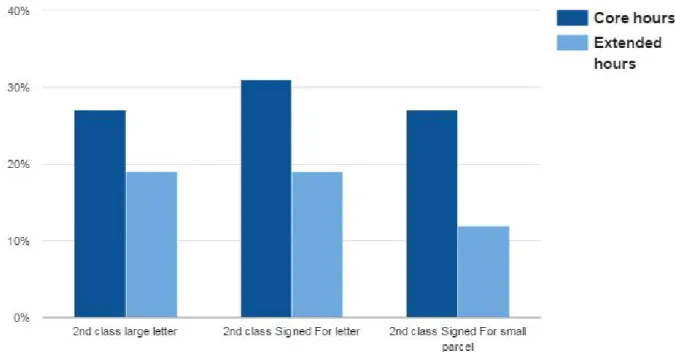
Conclusion
Free, confidential advice
Whoever you are
